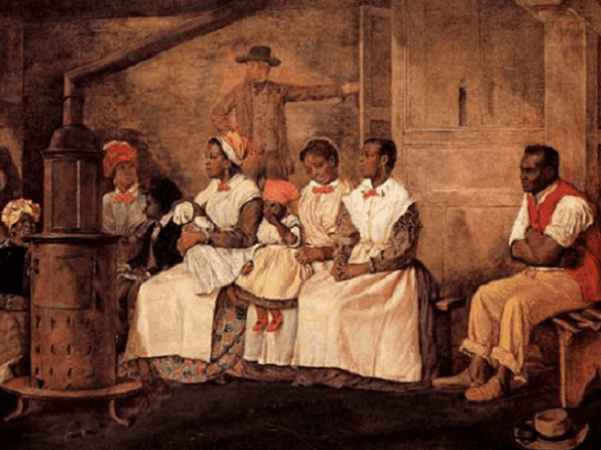Introduction: In this article, Gena Philibert-Ortega searches old newspapers and other online resources to learn more about the African slave trade in America. Gena is a genealogist and author of the book “From the Family Kitchen.”
Throughout the course of the Atlantic Slave Trade, an estimated 12 million Africans were captured in their homeland and forcibly shipped across the Atlantic, on more than 35,000 voyages, starting in the 17th century* The African Diaspora scattered Africans throughout the Caribbean and Americas. The first slave ship to land in Colonial America went to Jamestown, Virginia, in August 1619. The name of the first African slave ship out of the United States was Desire, which sailed out of Massachusetts eighteen years later. This forced migration caused the displacement, torture, enslavement and murder of many Africans.**
African slaves brought to the Americas were part of the “Middle Passage,” a voyage that began in Europe, stopped in Africa to unload supplies and pick up enslaved human cargo, and then traveled to American ports on the eastern coast to trade that human cargo for goods that were then shipped back to Europe.
History of the African Slave Trade in Early America and the United States Infographic (Note: the article continues after this infographic.)
This troubling part of American history—and important part of African American history—can be uncovered and explored with patient historical research, including searching in old newspapers such as GenealogyBank’s online Historical Newspaper Archives.
Laws Slow—but Don’t Stop—the African Slave Trade
It would seem that the African slave trade to America would have been stopped by a law passed by the U.S. Congress in March 1807 that stated:
“That from and after the first day of January, one thousand eight hundred and eight, it shall not be lawful to import or bring into the United States or the territories thereof from any foreign kingdom, place, or country, any negro, mulatto, or person of colour, with intent to hold, sell, or dispose of such negro, mulatto, or person of colour, as a slave, or to be held to service or labour.”***
Genealogy Tip:
Read more about U.S. legislation in the 1800s regarding slavery in GenealogyBank’s Historical Documents section which contains The American State Papers and more.
However, the Act to Prohibit the Importation of Slaves and a similar law passed in the United Kingdom didn’t end the practice of the slave trade. Slave ships illegally continued to bring their human cargo to U.S. ports, and American newspapers continued reporting on the occasional capture of a slave ship into the 1840s. (Two ships, the Wanderer and the Clotilde, are reported to have brought slaves to the United States well into the 1850s.) As with the passage of most laws, those who would break the law don’t end their criminal deeds; instead a black market thrives.
Slave Advertisements in Newspapers
Eighteenth-century newspapers found in GenealogyBank’s archives report of the comings and goings of slave ships, when the African slave trade was still legal. From advertisements to shipping news articles, researchers can find mentions of slave ships names, their captains, and descriptions of the people on board.
In some cases, advertisements for the upcoming sale of slaves included information on the ship they would be arriving on. In this example from a 1785 South Carolina newspaper, Fisher & Edwards advertise that the ship Commerce, under Captain Thomas Morton, will be arriving from Africa’s Gold Coast with “upwards of 200 prime slaves” for sale.
An earlier South Carolina advertisement proclaims that the slaves aboard Captain Buncombe’s ship Venus are “mostly stout men.”
Slave Ship “Shipping News” in Newspapers
Articles under “Shipping News” or “Marine List” headlines are a good place to start searching for information about slave ships, crew, and cargo.
In this example from a 1799 New York newspaper, we see updates on various ships including information about deaths on ships. We also see that the Gurbridge and Mary were bringing slaves, and to whom they were being brought.
Where to Find African Slave Trade & Slave Ship Records
- After exhausting your research in newspapers, learn more about a particular slave ship by consulting the Trans-Atlantic Slave Trade Database website, which houses information about slave ships from 1514 to 1866.
- In some cases digital collections may hold slave ship manifests, such as this example from the Metropolitan New York Library Council Digital Collections.
- Don’t forget to look for finding aids like this one from the New York Historical Society’s Guide to the Slavery Collection 1709-1899.
The National Archives (NARA) houses resources that can assist in your research, such as:
- The Slave Manifests of Coastwise Vessels Filed at New Orleans, Louisiana, 1807-1860 website has “manifests filed with the collector of customs at New Orleans, Louisiana, of slaves transported in coastwise trade to or from New Orleans during the period 1807-1860.”
| African American Slave Trade Infographic Research Sources: |
These online websites can be helpful, but research on the name of a slave ship should begin with historical newspapers. It’s in their advertisements and news articles that you will find mentions of the slave ships’ cargo, crew, and destination. You are free to share the History of the African Slave Trade in Early America and the United States Infographic on your blog or website using the embed code below. __________________ * The Trans-Atlantic Slave Trade Database. http://www.slavevoyages.org/tast/index.faces. Accessed 23 February 2014. ** “March 2, 1807.” This Week in History, March. http://www.peacebuttons.info/E-News/images/peacehistorymarch.htm. Accessed 23 February 2014. *** “An Act to Prohibit the Importation of Slaves into any Port or Place Within the Jurisdiction of the United States, From and After the First Day of January, in the Year of our Lord One Thousand Eight Hundred and Eight.” The Avalon Project. Yale Law School Lillian Goldman Law Library. http://avalon.law.yale.edu/19th_century/sl004.asp. Accessed 23 February 2014. |

